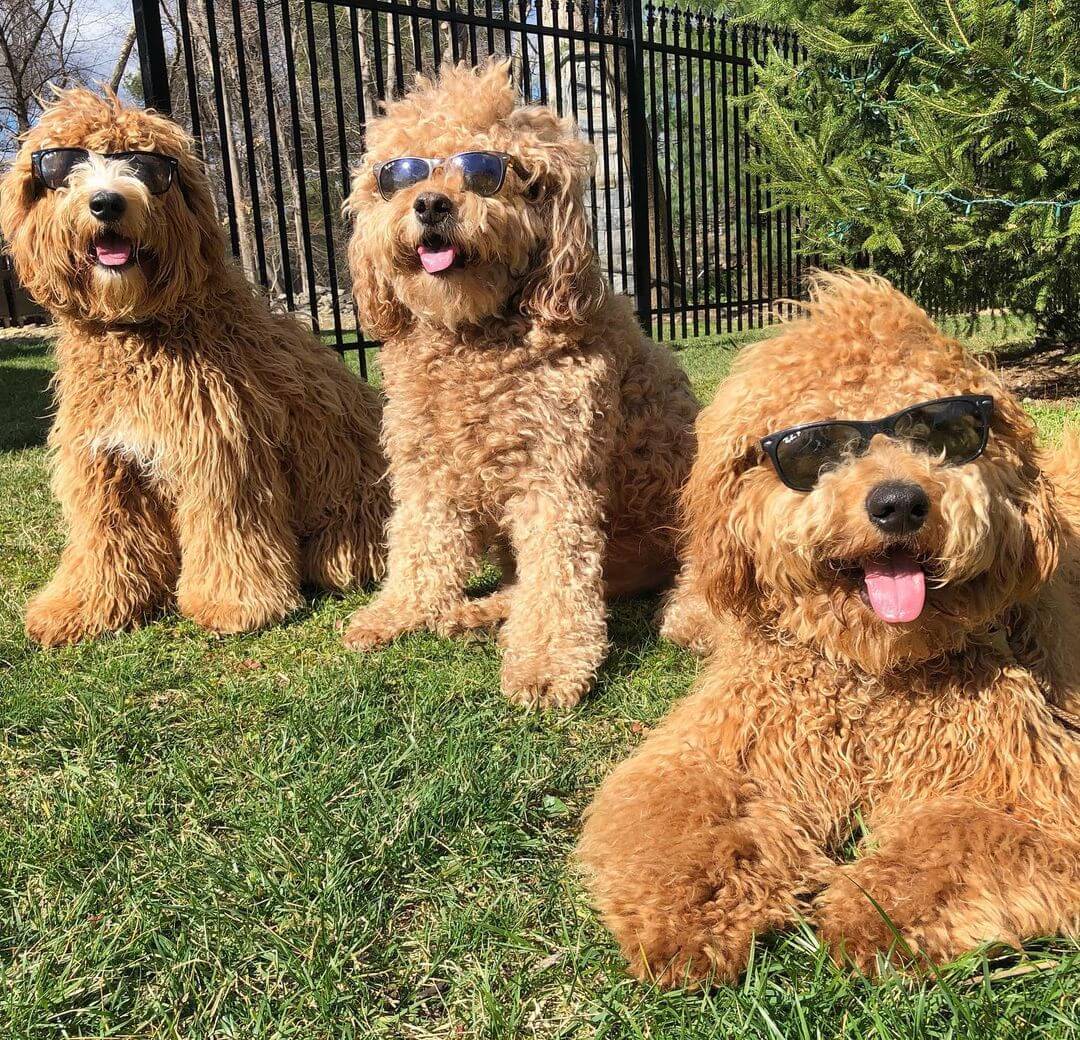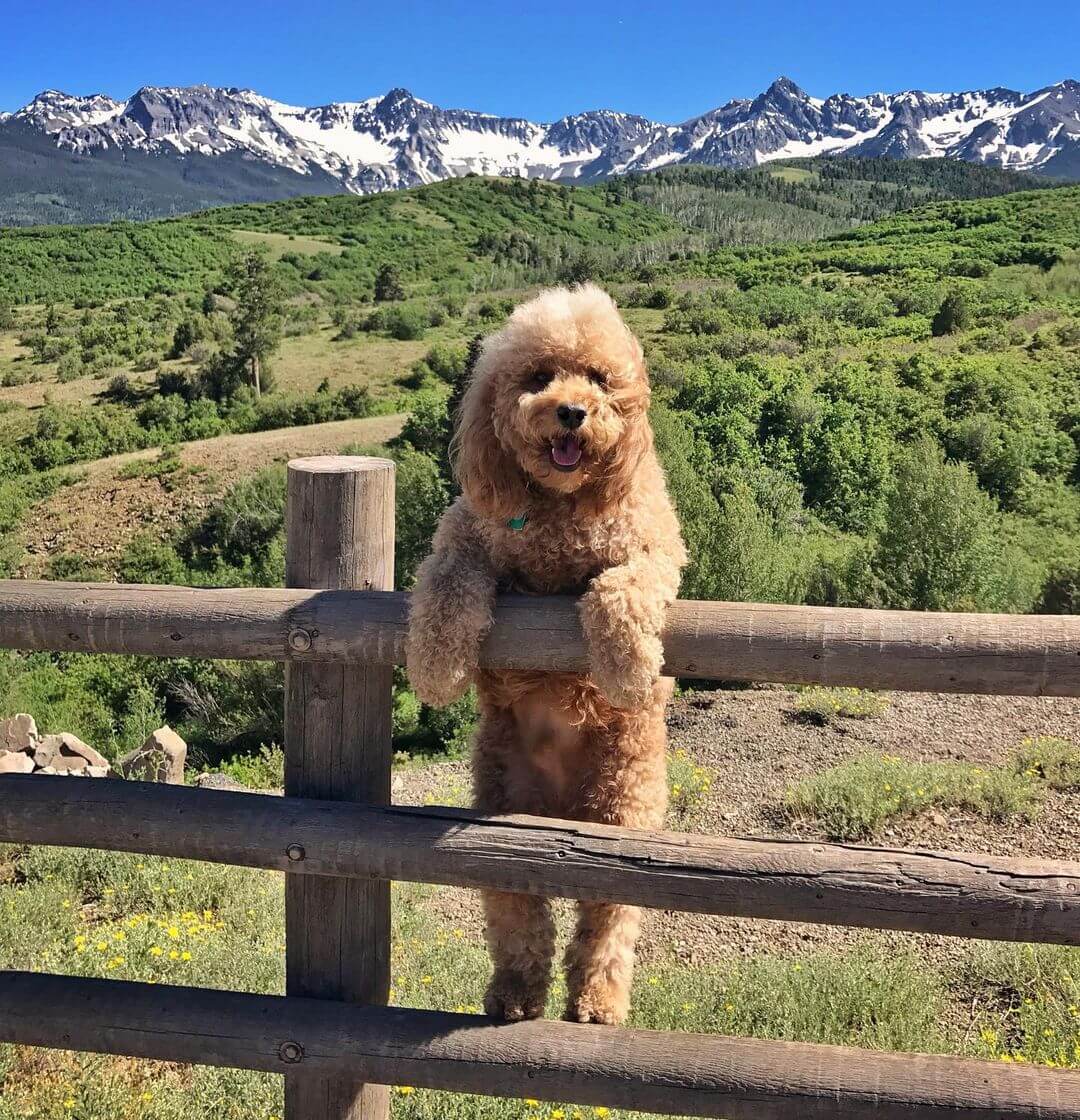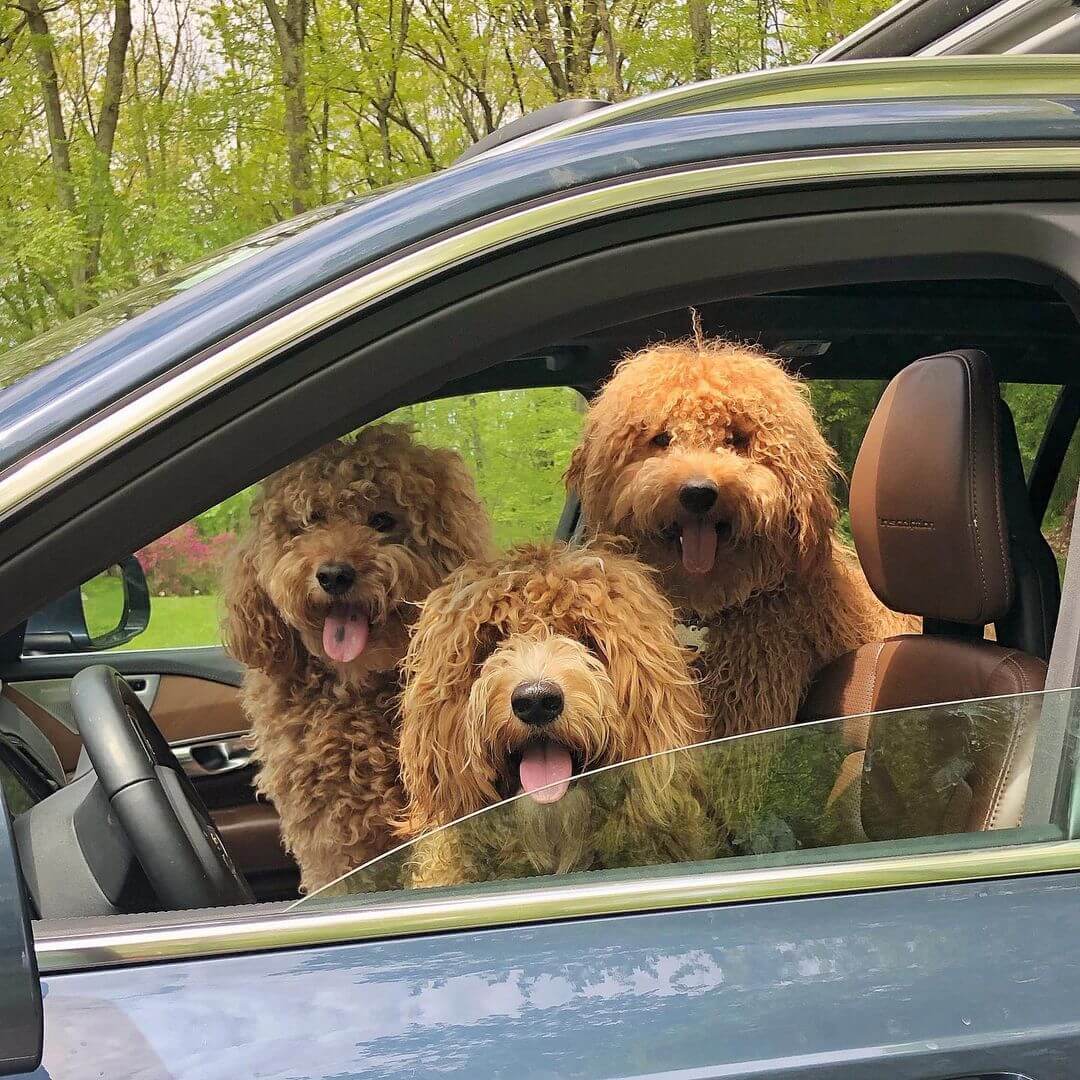The aspirations of breeders to breed such a breed of dogs, the external data of which would not differ much from the “parental” ones, but at the same time, the qualities and characteristics were borrowed from the good-natured Golden Retrievers, were crowned with success. The bred Goldendoodle breed of dogs has borrowed all the positive qualities of its “ancestors” and has recently been gaining more and more popularity.
With their striking features, Goldendoodles are gaining universal recognition, as evidenced by the increasing demand for them.
Brief Information

- Origin: United States of America (USA).
- Recognized by: not recognized.
- Life span: 10-15 years.
- Group: companion dogs, decorative dogs.
- Temperament: active, friendly.
- Size: small, medium, standard.
- Height: 35 to 65 cm.
- Weight: 11 to 34 kg.
- COAT: Shaggy with curls or shaggy and wavy.
- Coat color: solid white, cream, golden, red, copper, brown, black.
- Molting: minimal. Litter: from 5 to 8 puppies.
Personality

The temperament, borrowed from Golden Retrievers (Goldens), characterizes Goldenddles as a companion dog, as indicated by its playful, kind, and inquisitive nature. Activity and sociability make this breed a central element in the home. This is evidenced by her desire for communication and attention.
Unfortunately, such good-naturedness of the Goldoodle, as in the case of the Golden Retrievers, negatively affected the quality of the guard, making them unimportant “defenders of the house.” The patience of this breed knows no boundaries, therefore, in families with small children, it is a nanny dog whose kindness will not allow to harm the child. This same quality allows her to coexist peacefully with other pets at home.
A feature of this breed can be considered the expression “smile” on the face borrowed from the Goldens. The intelligence of the Goldoodles is quite developed but requires constant “training”. Active training at a young age and playful “training” for obedience throughout life give the dog intelligence and dexterity.
History

The emergence of Goldendoodles was the intention of breeders to breed such a breed, the coat of which would not cause allergies, and the predisposition to genetic abnormalities and shedding would be minimized.
The first generation of the breed was bred in 1990 as a result of mating a poodle and a golden retriever, and the name was borrowed from the example of the Labradoodle breed. To the general regret of the breeders, as a result of such mating, only one of the “parents” prevailed, and the description and characteristics of puppies from the same litter did not match. Subsequent experiments by breeders have revealed the fact that the qualities of puppies born as a result of crossing a Golden Retriever with a Golden Retriever or Poodle have better qualities than puppies obtained in the first generation.
As a result of incessant experiments, in 2002, a new miniature species of this breed was bred, obtained as a result of mating a Golden Retriever with a toy poodle. But at the moment this breed has not won the status of a “pocket dog”. Also, despite all the efforts of the breeders, this breed is not recognized by kennel clubs today, but the “Goldendoodle Association” founded in North America contributes to its standardization.
House or Apartment?

The conditions for keeping pets off the Goldendoodle breed do not play a big role. But, it is worth considering that activity and energy in “cramped circumstances” can bring undesirable consequences, such as damaged wallpaper, furniture, interior items, and personal belongings of household members. Living in a small apartment, the pet must be given enough time for walking and active games outside the home.
When it comes to decorative sized dogs, small apartment conditions are fine, but the need for energy in the open-air remains the same as in standard-sized breeds. For large dogs, however, the best option for a living is a house with free-range.
Care and Maintenance

The main care of a pet consists of a set of measures aimed at maintaining a neat, well-groomed appearance and health of the pet.
- Wool
Breast wool has average indicators of “ancestors” – shaggy with curls. Like Goldens, this breed has no undercoat, which is reflected in the absence of such a phenomenon as shedding. Despite this, the need for constant combing remains. These actions prevent the formation of tangles and make the appearance more presentable.
You can get rid of dog hair with a furminator, and you can also use a clipper. It is necessary to accustom the puppy to this unpleasant procedure as early as possible, and it is necessary to comb it 2-3 times a week using a comb with rare teeth. Important! Using a comb with sparse teeth does not injure the skin of the animal and does not bring much discomfort when combing unruly curls.
- Ears, eyes, teeth
High activity of dogs involves getting dust and dirt in the ears, so ear cleaning should be done at least once every 2 weeks. Cleaning is carried out with a cotton swab dipped in vegetable oil. If the financial situation allows, then cleaning can be done using special solutions designed for these purposes. You can buy them in veterinary pharmacies, where their range is wide enough. The “ancestors” (namely the poodle) influenced such a property as the tendency to accumulate hair in the ears, so timely cleaning will avoid the accumulation of hair, excessive pollution, and prevent diseases.
Breast eyes also need constant care. Thick hair on the face is prone to accumulation of dust and dirt on it, and getting into the eyes of the growing hair contributes to inflammation of the conjunctiva. Being active outdoors with your pet also exposes your dog’s eyes to external influences, so weekly cleansing of the eye area is important.
Important! The ears of the dog are too sensitive to the noise of rain, this explains the resistance to walking the pet in rainy weather.
You can clean the eyeball with a piece of gauze or a cotton pad dipped in boiled water, tea leaves, or a special solution purchased from a veterinary pharmacy. All movements should be light and careful from the outer corner of the eye to the inner corner.
In order not to face diseases of the pet’s oral cavity, the dog’s teeth must be periodically (at least once a week) cleaned of food debris. An ordinary soft toothbrush is suitable for this procedure, and it is better to use a special “for dogs” toothpaste as a toothpaste. Initially, the pet may resist the brushing process, but, getting used to it over time, will allow you to brush better.
- Bathing
It is important to maintain balance and moderation in keeping your pet neat. A dog, like an animal, does not need constant cleanliness and bathing. The desire to see a dog clean is a need for aesthetic pleasure for humans.
Important! The bathing procedure should be regulated by weather conditions or necessity.
The best option for taking “bath” procedures is once a quarter, but for excessively clean owners, bathing your pet should not be done more often than once a month. The fact is that tap water decreases the dog’s skin, and the use of cosmetics unnecessarily dries out the skin, making it more susceptible to weather conditions.
An excellent substitute for the standard bathing procedure is the use of special “dry” shampoos. The choice of such hair care products is wide, and there are also budget options in price categories.
Physical Activity

Goldendoodles have a high need for physical activity, so this breed of dog requires more time to walk. The minimum allowable amount of time for such dogs to walk is 2 hours a day, 1 hour each in the morning and evening.
There is no such need for dogs living in large houses with the possibility of free walking, but frequent walks over long distances will have a beneficial effect on the physical condition of the pet.
Goldoodles, like the “ancestors” of the Golden Retrievers, are genetically prone to gaining weight, so high physical activity will help maintain optimal body weight.
Feeding

The development and condition of the body of a dog of any breed depend entirely on the diet consumed. As for the gold poodles, there is no special menu for them. It is important in the desire to feed the dog to adhere to reasonable limits, not overfeeding, but also not leaving the dog hungry.
The choice of the type of feeding depends on the preference of the owner and can be natural or using specialized “dry” dog foods. With natural feeding, it is important to consider a balanced menu to ensure that the body receives the necessary nutrients and vitamins.
With “dry” feeding, this issue is irrelevant, since each pack of such food contains all the substances necessary for the body in the right amount. The amount of a portion of food depends on the size of the dog and is 60-450 g per day, divided into 2 daily meals … The dog should have clean water available at all times.
Important! The mixed type of food (natural and dry) negatively affects the gastrointestinal tract of the dog and provokes gastritis.
Education and Training

This breed of dog requires constant training and obedience lessons, so walking and active games should include elements of training. By persuading the dog to perform commands or certain “tasks” in games, the tone of the nervous system is maintained, which increases intelligence and quick wits. Such a pet has good character and obedience.
Health and Disease

One of the reasons for breeding the breed was to reduce the risk of genetic abnormalities, so the Goldendoodle breed is distinguished by better health, unlike its “ancestors”.
Typical diseases of the breed include:
- dysplasia of the hip and elbow joints;
- dry skin;
- diseases of the eyes and ears;
- the manifestation of food allergies.
Goal

Goldendoodles are usually bred as family companion dogs and are also used as guide dogs, service dogs, and dogs for the treatment of humans. Goldendoodles are great for hunting waterfowl, and many of them are excellent swimmers.
In most cases, Goldendoodles are produced by those who like Golden Retrievers, but also want the dog to shed less or be hypoallergenic. Others speculate that the hybrid breed will be less prone to cancers that afflict golden retrievers. Not all Goldendoodles shed as little as poodles but significantly less than golden retrievers. The degree of shedding can vary from dog to dog. The grooming rules also differ depending on the type of coat.
Goldendoodle is a little-known hybrid dog breed with its own characteristics and advantages. A dog of this breed is distinguished by high contact and friendliness, its devotion to its owners knows no boundaries, and its patience with small children and other animals gives the breed a special quality – a nurse-dog. But the breed also has some disadvantages: a tendency to certain diseases, indiscipline, the manifestation of which can be minimized by the presence of active games, lessons of training, and obedience.